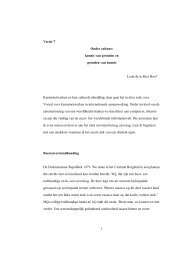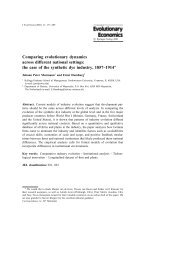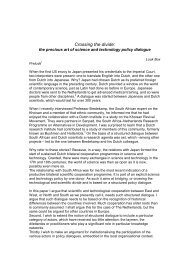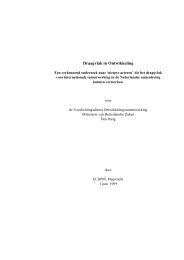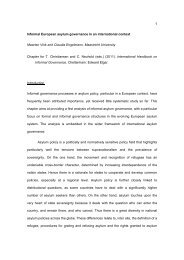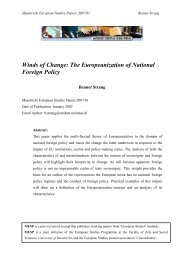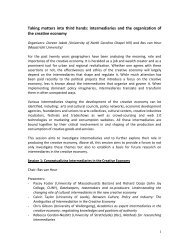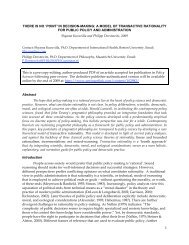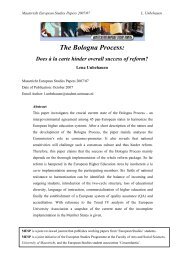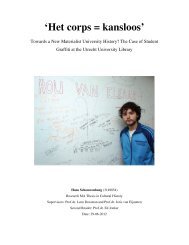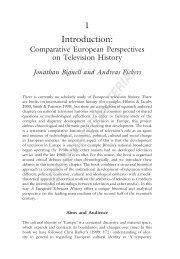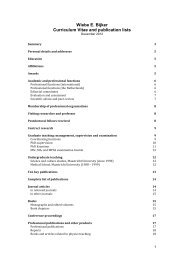About the Journal - Cities Institute
About the Journal - Cities Institute
About the Journal - Cities Institute
Create successful ePaper yourself
Turn your PDF publications into a flip-book with our unique Google optimized e-Paper software.
of <strong>the</strong> public that he creates through his writing” (Newman, 2008, p. 53). Thus, <strong>the</strong><br />
critic creates <strong>the</strong> public he both impersonates and addresses – when looking a bit<br />
closer at some British and Swedish reviews of Africa Remix, a touring ”blockbuster”<br />
exhibition visiting Düsseldorf, London, Paris, Tokyo, Stockholm and Johannesburg<br />
between 2004 and 2007. The works of approximately 70 to 90 artists were on show in<br />
each location.<br />
In his review of Africa Remix in The Guardian – after fiercely criticising <strong>the</strong> exhibition,<br />
and being confident enough to state that it “misdescribes <strong>the</strong> continent” –<br />
Jonathan Jones reveals that “[i]n <strong>the</strong> end, this is a subject I probably shouldn't even<br />
be writing about. What do I know?” (Jones, 2005). If this is <strong>the</strong> case, why does he<br />
make all <strong>the</strong>se statements about <strong>the</strong> exhibition in <strong>the</strong> first place? The only art at <strong>the</strong><br />
exhibition Jones is complimentary about are Chéri Samba‟s (colourful) paintings,<br />
since ”Samba seems to tell us about African contemporary life, ra<strong>the</strong>r than setting<br />
out to fit into a global art system” (Jones, 2005). While The Guardian’s treatment of<br />
<strong>the</strong> exhibition was not entirely expected, it is less surprising that Brian Sewell of The<br />
Evening Standard – considering his well-known aversion to female artists, for<br />
example – describes <strong>the</strong> exhibition as a ”wretched assembly of posttribal artefacts,<br />
exhausted materials re-used, and what would easily pass for <strong>the</strong> apprentice rubbish<br />
of <strong>the</strong> European art school” (Sewell, 2005).<br />
Both Jones and Sewell are confident in <strong>the</strong>ir role as critics within a discourse that<br />
takes for granted “<strong>the</strong> idea of <strong>the</strong> European identity as a superior one in comparison<br />
with all <strong>the</strong> non-European peoples and cultures” (Said, 1978, p. 7). Jones‟s halfhearted<br />
“excuses” only adds to what Rory Bester argues is <strong>the</strong> “inability to see<br />
beyond what <strong>the</strong> ethnographic code offers” (Bester, 2009, p. 83).<br />
The approach of <strong>the</strong> Swedish critics appears to be slightly different. In her review in<br />
Dagens Nyheter, <strong>the</strong> leading Swedish quality newspaper, Jessica Kempe shows a<br />
more positive attitude to <strong>the</strong> exhibition, but diminishes <strong>the</strong> importance of <strong>the</strong><br />
artworks when she implies that <strong>the</strong> quality does not matter: ”Good or bad<br />
exhibition? Irrelevant question!” (own translation) (Kempe, 2006). When studying<br />
reviews in all <strong>the</strong> major national and local newspapers, what stands out is <strong>the</strong><br />
faiblesse for discussing how one is expected to view African art and how African art<br />
was previously viewed (Lindén, 2009). Even if this, of course, is discussed critically, <strong>the</strong><br />
focus is placed on <strong>the</strong> expectations of <strong>the</strong> public. Thus <strong>the</strong> critics assume that <strong>the</strong><br />
visitors‟ idea of African art and culture has not changed over <strong>the</strong> past century. In<br />
addition to this, <strong>the</strong> reviewers separate <strong>the</strong>mselves from <strong>the</strong> public by describing <strong>the</strong><br />
imagined expectations of <strong>the</strong> general visitor, and that <strong>the</strong>y <strong>the</strong>mselves stand above<br />
this. It is clearly decided by <strong>the</strong> critics what public <strong>the</strong>y are addressing, in that <strong>the</strong><br />
readers‟ initial expectations of Africa Remix would be that of an exhibition<br />
promoting <strong>the</strong> idea of contemporary African art as naïve, colourful and primitive –<br />
what we might call an “ignorant” public; a public that is both created and<br />
impersonated by <strong>the</strong> critic.<br />
This small sample suggests that both <strong>the</strong> British and Swedish critics promote a<br />
condescending attitude towards <strong>the</strong>se exhibitions, thus conforming to a eurocentric<br />
view of African art. The tactics are different of course, <strong>the</strong> Swedish critics being more<br />
cautious and aware of postcolonial structures, but ”<strong>the</strong> inability to see beyond what<br />
<strong>the</strong> ethnographic code offers” is still evident. In 1994 when Okwui Enwezor launched<br />
35



